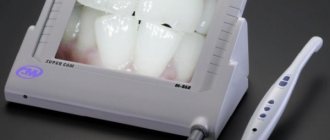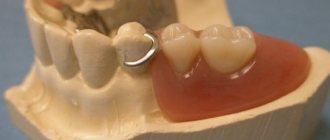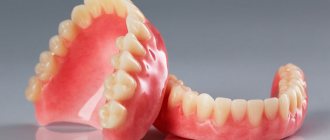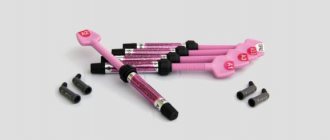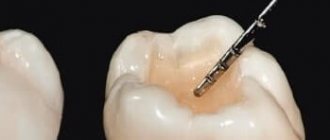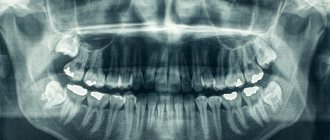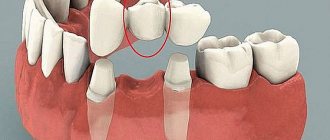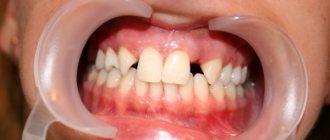6942
Is it possible that during a visit to the dentist, holding your mouth wide open for a long time leads to muscle spasm? It turned out that this is possible.
In this case, one of the recommendations of practicing dentists is the use of an Optragate mouth opener.
The device is manufactured in Liechtenstein at Ivoclar Vivadent. The official name of the retractor is OptraGate.
Definition
Dental retractors
Dental retractors are used for retraction of soft tissues (to move tissues directly away from the tooth). This is done to provide convenient access to the tooth that is planned to be treated.
Externally, retractors vaguely resemble tweezers. However, the tips of the instruments can have different shapes: rounded, sharp, curved at certain angles, and can also be in the form of blades, plates or even hooks. Retractor sizes can also vary.
Different retractors are used to work in different areas of the oral cavity.
To abduct the cheek when operating in the back of the oral cavity, a Lagenbeck hook (named after the inventor's name) is used.
When performing surgery in the front part of the mouth, as well as when operating on the alveolar process, the Farabeuf retractor is used.
When operating in the lower part of the mouth, in order to retract the tongue and not injure it, you need to use a Deaver retractor.
A Kocher retractor is used to separate the edges of the skin around the wound. In another way, all these retractors are called hooks in combination with the name of their inventor.
The instruments are made from high-quality stainless medical steel. These tools are rust resistant. They can be sterilized at high temperature.
There is a special type of retractor - for the distal areas of the dentition. It is used for easier access to the operated field of the distal areas of the dentition. They are most often used when working with the lower rows of teeth, as well as in the therapeutic restoration of chewing teeth.
General presentation and purpose
The developers of Ivoclar Vivadent (Germany) have created a three-dimensional circular retractor, the quality of which has already been appreciated by dentists around the world.
Optragate is a tool that makes the dentist’s work easier. It allows you to increase the working area in the oral cavity, without causing much inconvenience to the patient.
The instrument has many differences from other rigid systems used in dentistry. It allows you to isolate the patient’s cheeks and lips during therapeutic or surgical dental treatment.
The device differs from conventional mouth openers in that it is installed in a couple of movements. In this case, all elements of the jaw rows become available to the specialist.
The Optragate Retractor reduces the risk of injury due to jaw muscle spasms caused by postural fatigue.
Hard retainers also cause micro-wounds in the oral cavity. Modern equipment eliminates the possibility of such damage.
Using Optra Gate
OptraGate is a new development for dentists
Optragate is a modern assistant for dentists by increasing the working surface in the oral cavity, without causing unnecessary inconvenience to the client.
The OptraGate dental retractor is an amazing development for isolating a person’s cheeks and lips during dental intervention in the oral cavity.
The main difference compared to older conventional mouth openers is that OptraGate can be installed with just a few hand movements. Thus, isolating the mucous membranes of the cheeks and lips, as well as minimizing the possibility of injury associated with accidental spasms due to fatigue of the patient’s jaw muscles.
The OptraGate dental retractor is an amazing development for isolating a person’s cheeks and lips during dental intervention in the oral cavity.
General characteristics and functionality
Optragate is an auxiliary tool whose purpose is to make the dentist’s work easier. With its help, the accessible area of the oral cavity increases without causing a negative reaction in patients. Unlike rigid frame fixation systems that can lead to microtrauma, optragate effectively isolates soft tissues and protects them from possible mechanical impact. There is also a positive impact of the use of the device on the statistics of spasmodic injuries of the jaw muscles that occur due to prolonged stay in an uncomfortable static position.
The popularity of the optragate is determined by the convenience and efficiency of its use. Installation of the expander is carried out in several movements, and allows access to all elements of the dentition, including hard-to-reach molars. The soft and flexible system easily adapts to the anatomical features of the patient's oral cavity without causing inconvenience or discomfort.
This is interesting: Types and advantages of the fluoridation procedure for baby teeth in children
The device does not contain any allergenic or toxic substances. The installed design does not provoke the mucous membrane to negative reactions. Optragate is optimal when it is necessary to provide dental care to patients suffering from hypersensitivity of teeth and gums, as well as in cases where there are ulcers or minor tissue damage in the oral cavity.
Properties of the Optragate mouth opener
The main difference between the Optragate mouth opener and the bulk of similar devices is its phenomenal ease of use. It is so simple that it can be worn not only by an inexperienced dentist, but also by the patient himself. Moreover, it can also be easily removed if necessary. It is recommended to blot it with water before use, which will make putting it on easier. We list other properties:
- The retractor can be selected for patients of all ages. There are also models designed specifically for children.
- Optragate easily fits any jaw structure due to its flexibility. The retractor literally adapts to the position of your lips and gums.
- When using Optragate, any inflammation and skin reactions are excluded. This is due to the fact that the Optragate retractor is made of environmentally friendly substances that are harmless to the body.
- For patients with increased sensitivity, special retractor models have been developed, characterized by particularly soft material.
It is worth mentioning and listing the types of retractors today. There are 3 varieties in total:
- OptraGate Regular is the standard retractor type for most jaws;
- OptraGate Small - for people with small jaws;
- OptraGate Junior is, accordingly, a children's retractor model.
In addition to the main types, there is a special type with a particularly soft surface called OptraGate ExtraSoft.
When should you use OptraGate at the dentist?
OptraGate has a wide range of applications, both in ordinary treatment cases and in complex situations:
- In the manufacture of restorations of any type;
- For restorations of anterior teeth, which are highly aesthetic;
- When installing class V seals;
- For cosmetic treatment;
- For clinical teeth whitening;
- During professional teeth cleaning;
- In the treatment of periodontal diseases;
- In cases of receiving impressions.
Using OptraGate Photo
Installation Rules
The optragate is easy to install, the device does not require any skill and does not cause any difficulties during operation. Installation can be done even with one hand.
However, before using the device, you need to determine some factors.
First, you need to select the desired size retainer. This information, as well as other necessary information, is indicated directly on the packaging.
It is also useful to know that the retractor is fixed even easier if you rinse it with water in advance. When installing, the device is first put on the inside of the mouth, and then attached to the outer surface.
In this case, the outer ring with the wings must be left outside. After completing the work, the device can be easily removed by pulling the ring.
Advantages and method of application
In comparison with other retractor models, we can highlight a number of clear advantages that Optragate has:
- safety of use - the retractor provides free access to the working area, while maintaining the usual state of the jaw muscles and soft tissues;
- preventing saliva from entering the working area, which eliminates the possibility of infection of the open cavity of the tooth or pulp;
- convenience for the patient - when performing a surgical intervention of increased complexity, the duration of the operation can exceed several hours. The three-dimensional flexible design relieves a significant part of the load and facilitates the transfer of the operation;
- versatility of use – the absence of allergenic and toxic components allows the retractor to be used by almost any patient;
- ease of installation and removal – design features eliminate the need to use force when installing and removing the retractor;
- wide functionality of application - the expander can be used in most operations that require free access to the entire oral cavity;
- the presence in the manufacturer’s line of several sizes, as well as models for children;
- favorable price - since the retractor is a disposable instrument, its price is included in the cost of medical services.
The Optragate retractor is used in various situations - both for routine sanitation of the oral cavity and during surgical operations. In general, the expander is recommended for use in the following circumstances:
- installation of fillings as part of endodontic root canal treatment;
- carrying out cosmetic therapeutic procedures, including whitening;
- technical cleaning of enamel from plaque and tartar;
- carrying out restoration on the frontal areas of the dentition;
- removal or treatment of hard-to-reach molars and wisdom teeth;
- prevention and therapy of periodontal diseases.
This is interesting: Tablets for toothache: strong painkillers, the best remedies for tooth pain
The expander installation procedure does not require any special skills or experience. The retractor can be fixed even with one hand - the main thing is to correctly determine the size of the system. For a clearer fixation, it is recommended to rinse the structure with water before starting installation. To quickly and painlessly remove the structure, just pull the special ring.
Reviews
Have you ever received treatment using Optragate? Was it soft and comfortable? Was a separate amount of money paid for this expander or was the retractor included in the cost of treatment?
Dentists who use the products in their practice can also share reviews about the OptraGate retractor. You can leave your reviews in the comments to the article.
If you find an error, please select a piece of text and press Ctrl+Enter.
Tags dentist tools
Did you like the article? stay tuned
No comments yet
Other modifications
Small Regular Junior
Optragate Extra Soft Version : instructions for use
The OptraGate Small soft lip retractor is an innovative means of isolating the patient’s lips and cheeks during dental procedures. Unlike traditional rigid mouth retractors, OptraGate allows you to insert the retractor into the patient's oral cavity with one movement of your free hand and ideally isolate the mucous membranes of the lips and cheeks.
In addition, traumatic injuries associated with the possibility of biting, which are quite common when using a traditional rigid retractor, are excluded.
OptraGate can be used in a variety of procedures: direct and indirect restorations, highly esthetic anterior restorations, Class V fillings, cosmetic treatments, professional teeth cleanings, clinical teeth whitening, periodontal treatment, impressions, CEREC, etc.
OptraGate is a completely new aid for increasing the working area simply, effectively and comfortably. The lips and cheeks are completely retracted, thereby ensuring relative isolation of the working area from saliva.
OptraGate is comfortable even during prolonged application due to its three-dimensional flexibility. OptraGate provides dentists and assistants with simplified access to a noticeably larger work area. The device creates a gentle circular retraction of the lips and cheeks from the front to the back teeth without the use of any bulky instruments.
The lips are completely covered, thereby ensuring their protection. The three-dimensional flexibility and elasticity of OptraGate does not limit the movement of the lower jaw, therefore, it can remain in the oral cavity from the beginning to the end of treatment.
OptraGate is completely latex-free and can therefore be used in patients with latex allergy. The device is easily and quickly applied and removed by one person without assistance.
Price
The price of a retractor varies depending on the choice of supplier. It is not difficult to find Opragate on sale. For example, you can order a retractor on the websites of official suppliers.
On average, the price is for 1 piece. standard extender is 90 rubles. The dentist can save some money by purchasing the whole package. One box contains 80 pcs. Further in the table the prices for 1 piece will be indicated. and for the whole package.
| Name, size | Cost per piece in rub. | Packaging price in rub. |
| OptraGate Extra Soft standard (1 pc.) | From 90 | From 7 137 |
| OptraGate Extra Soft small (1 pc.) | From 89 | From 7 137 |
| OptraGate Extra Soft for children (1 pc.) | From 110 | From 7 596 |
Optragate is a convenient and easy-to-use mouth opener. Used in many dental activities. The price of the retractor is relatively low. It is possible to use it for patients with allergies to latex fabric.
The video provides additional information on the topic of the article.
Indications for use
A retractor from a German manufacturer can be used in different situations - during routine sanitation and during complex surgical interventions.
List of main indications:
- filling deep carious cavities during endodontic treatment of root canals;
- cosmetic therapy - clinical teeth enamel whitening, restoration with composites;
- specialized teeth cleaning;
- restoration of the frontal zone;
- simple and complex removal of eights;
- treatment of periodontal diseases.
It won't hurt! 5 most pleasant and comfortable dental procedures
Many people still associate a visit to the dentist with pain and suffering. But modern doctors are sure: this myth should have been destroyed long ago, because dental care can bring joy and happiness.
● Today, the level of dentistry makes it possible to painlessly carry out any manipulation in the oral cavity, from caries treatment to implant installation. The equipment of the clinic, and, of course, the professionalism of the doctor plays a huge role in this matter.
PS I have completely stopped being afraid of doctors! Bravo!
Pulpitis and periodontitis
When caries penetrates deeply, when the “nerve” is affected (pulpitis), or when the disease spreads beyond the boundaries of the tooth root (periodontitis), edodontic treatment is necessary. This process consists of removing the “nerve” (pulp) followed by filling the canals. If the canals are treated incorrectly, the activity of microorganisms continues in them, contributing to a disease such as dental granuloma (cyst). In such a situation, it is necessary to “re-treat” the dental canals.
Endodontics – root canal treatment
Standard protocol for root canal treatment in our clinic:
- Anesthesia
- Isolation of the working field using a rubber dam
- Digital determination of canal length using an apex locator and X-ray diagnostics
- Instrumentation with rotating nickel-titanium instruments (endomotor)
- Irrigation protocol – flushing of canals for disinfection, activation by ultrasound
- Sometimes when treating root canals, temporary filling with calcium hydroxide preparations is necessary.
- Hermetic, three-dimensional filling of root canals using vertical hot condensation (BeeFill system)
- Sealed restoration.
The success of treating pulpitis directly depends on the level of equipment of the clinic. We use all existing modern working methods, tools and devices that have proven their worth. The clinic is equipped with the latest German and Italian equipment. All rooms are equipped with radiovisiographs. For effective treatment, an x-ray control method is used. Wireless scanners allow you to take pictures directly in the chair, which speeds up the procedure
Application (Full instructions)
The elastic material OptraGate ExtraSoft is stretched between two rings. A thicker ring is worn when working with a patient intraorally in the area of the transitional fold, while a thinner ring with two wings is located outside the oral cavity. The elastic part stretched between the rings can hold the patient's lips and displaces the rings due to the force created in the rubber (see photo 1).
- 1. Select the appropriate OptraGate ExtraSoft size. The size (R - regular (medium), S - small (small) or J - Junior (children)) is indicated on the packaging, as well as on the OptraGate ExtraSoft wing on the left side. Tip: It is recommended to lightly moisten OptraGate ExtraSoft with water before use, which makes it easier to put the device on the patient.
- 2. Donning can be done in the 12 o'clock position with the patient in the supine position, or in the 8 o'clock position with the patient seated, or in the 4 o'clock position for left-handers.
- 3. To make insertion easier, the thicker intraoral ring is wrapped around the thinner extraoral ring, with the wings of the OptraGate ExtraSoft pointing downwards. The user should place the top and bottom edges of the inner ring between the thumb and middle finger and squeeze lightly (see photo 2).
This is interesting: What is endodontics in dentistry and when is it used?
4. A slightly compressed intraoral ring is inserted from one side into the buccal corridor, so that the elastic parts are covered by the corner of the mouth, and the outer ring is outside the oral cavity (extraorally) (see Photo 3).
5. Once OptraGate ExtraSoft is fixed on one side, it should be positioned in the same way in the opposite corner of the mouth, slightly bending the ring (see photo 4).
6. The intraoral ring is then inserted behind the upper and lower lips, bringing the OptraGate ExtraSoft into its final stable position (see Photo 5). When the patient's mouth is relaxed, the intraoral ring slides easier and takes the required position.
If in some cases, when the mouth is completely closed, the intraoral ring begins to slip out of the lower lip area, most often it is enough to simply place the intraoral ring deeper. In any case, you can use a correspondingly different size.
This positioning of the OptraGate ExtraSoft improves visibility and access to the working area. By lateral movements of the lower jaw and wide opening of the patient's mouth, the working field can be further increased. To control occlusion, OptraGate ExtraSoft should not be removed.
7. To remove the OptraGate ExtraSoft, use a paper towel to grasp the extraoral ring from below and gently pull upward until the intraoral ring comes out of the lower transitional fold (photo 6). OptraGate ExtraSoft is then easily removed from the top transition fold and disposed of hygienically using a paper towel.
No. 5 Cofferdam. Convenience of the doctor or something more?
Thank you for subscribing to my posts, dear pikabushniks! Ask questions in the comments - there will be new notes. Previous post here. Today we’ll talk about such a device as a rubber dam (rubber dam, optidam and others – “ladies”).
A short excursion into history.
Dr. Rich first mentioned his innovative idea, which was called the “cofferdam,” in 1836. The idea was to isolate the tooth with gold foil, since the silver amalgam technology brought to America by the Crocourt brothers in 1833 required a dry surgical field when filling. Subsequently, thanks to the accidental discovery in 1839 by Charles Nelson Goodyear of the technology of vulcanizing rubber with sulfur, which produced latex rubber, it became possible to create rubber dams similar to those currently used in dentistry. On March 15, 1864, in New York, dentist Sanford Christie Barnum first used a rubber dam, and in June he gave a demonstration of the use of a rubber dam to colleagues at a meeting of the Society of Dentists in New York.
Thus, rubber dam has been used in dentistry for almost 200 years. In Europe, treatment using a rubber dam is a mandatory standard. In Russia he became famous after the fall of the Iron Curtain. But so far the widespread use of this device in our country has not been observed.
The rubber dam is a disposable latex scarf of various thicknesses and colors.
Holes are punched in the scarf using a special template.
The scarf is attached to the tooth using a special clip - a clasp. Clamps may vary in shape, size and material. If the tooth is severely damaged or has a streamlined shape, the clamp may come off. In this case, the tooth structure is not damaged.
When treating several teeth with a rubber dam, a group of teeth is isolated, this allows you to save on the cost of treatment (one scarf is used per visit, regardless of the number of teeth). After the clasp with the scarf is installed on the tooth, the scarf is pulled onto the frame. The edges of the scarf are carefully inserted between the teeth and inserted into the periodontal sulcus. The rubber tightly grips each tooth, preventing the penetration of liquids, dust, and various particles into the oral cavity and back.
After treatment is completed, the rubber dam is completely removed from the oral cavity.
So why is it needed?
The use of a rubber dam serves several purposes and has a number of advantages over other isolation methods:
1)
Isolation of the surgical field from the oral cavity.
The oral cavity contains a very large number of bacteria that cause caries and other dental diseases. If these bacteria, during the treatment process, enter a tooth or root canal prepared for filling, then in the future new caries will form under the filling, and a granuloma will appear at the top of the root (or roots) (in common parlance it is often called a cyst).
Previously, dentistry in Russia used cement and amalgam (metal) fillings, which were held in the tooth due to their volume and shape. Nowadays, composite materials are almost universally used in the treatment of caries. Basically photo-curable, which harden under the influence of light from a special lamp. These materials “stick” to the surface of the tooth. They allow you to treat cavities of arbitrary sizes and even ultra-small volumes. However, these materials impose much more stringent requirements for working with them. When placing a filling, the surface of the tooth must be absolutely dry and absolutely clean. Where moisture gets on the tooth or the surface is dirty, the filling does not stick; in these places, caries relapses or the filling simply falls out. Moisture in the mouth is not just saliva. Saliva from the sublingual salivary gland can easily get onto the upper teeth - it streams out of the gland when the mucous membrane dries out. Moisture is also contained in the air we exhale. This condensation settles on the surface of the teeth and prevents the filling from sticking (adhesion). The rubber dam completely eliminates the ingress of moisture and contamination of the tooth surface.
2)
Patient protection
A latex curtain covers the mucous membrane, moving the tongue and cheeks away from the doctor’s work area. Even if the doctor’s hand slips, the bur will only cut the scarf and will not injure your cheek, tongue, adjacent tooth or other tissues in the oral cavity. The scarf also protects against small instruments getting into the mouth, pharynx and respiratory tract. If suddenly a small instrument falls out of the tip or from the doctor’s hands, it will remain in the latex curtain and will not harm your health.
